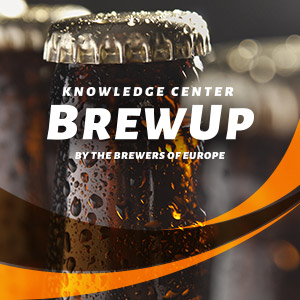
- advocate
- 14/03/2023
- 3504
- Caring for the planet
Packaging infographic
Discover how brewers are working to reduce, reuse and recycle beer packaging

Discover how brewers are working to reduce, reuse and recycle beer packaging

The Beer Statistics provide the statistics of the European brewing sector on production volume, consumption volume, export, import, jobs, tax revenues...for 2018.

This document is the Memorandum of Understanding on listing ingredients and nutrition information for alcoholic beverages as released on 05 September 2019 and signed by brewing companies of different sizes and national trade associations. Any company producing alcoholic beverages, or trade association thereof, can sign up to this Memorandum of Understanding. More information is provided on http://beerwisdom.eu

This document presents the brewers' ambition with regards to the implementation by the brewing sector of the Memorandum of Understanding on listing ingredients and nutrition information for alcoohlic beverages as available here. More information on the Memorandum of Understanding and on the brewers' ambitions can be found on http://beerwisdom.eu

This report provides the latest (September 2019) state-of-play of implementation by the brewing sector of its commitment to voluntarily equip consumers with the list of ingredients and nutrition information of the beer they consumed. More information on the commitment and its implementation can be found on http://beerwisdom.eu

This infographic shows the declines in the harmful use of alcohol in the WHO EURO region between 2010 and 2016, including on heavy episodic drinking, alcohol-related deaths and number of years of life lost (DALYs).

Ths infographic shows the declines in the harmful use of alcohol (heavy episodic drinking and alcohol-related deaths) in the European Union, Norway and Switzerland between 2010 and 2016.

This Infographic explains why Europe’s brewers call for a sustainable tax regime.

This report analyses the impact of changes in excise taxes across the European Union (EU). The analysis considers the impact on consumption, Government revenues, profitability in the brewing sector and direct and indirect employment. It also studies the comparable costs in the route to market for the different categories of alcoholic beverages across the European Union. The focus of that part of the report has been on the main drinks categories, being beer, wine and spirits.

This report provides for an assessment of the economic contribution of the hospitality sector across 31 European countries.

This report provides an analysis of European consumers’ information needs and preferences regarding alcoholic beverages. The results show that whilst consumers’ knowledge of the nutritional value and ingredient information of alcoholic beverages is very limited, there is interest to receive this kind of information, and an interest in accessing it through off-label channels such as websites and applications.

This Infographic sums up at a glance the most striking findings from the GfK report “Consumer Insights: Knowledge of Ingredient and Nutrition Information of Alcoholic Beverages, Off-Label Information and its Use”.

This follow-up study builds upon a previous consumer survey done in 2014 in 6 European countries and released in March 2015. It specifically examines consumers’ call for receiving the same ingredients and nutrition information for all alcoholic beverages as currently provided on all other food and drink products, the interest in the ingredients information, the calorie information and the full nutrition information on alcoholic beverages as well as the different information sources that consumers would like to use to access this information. GfK Belgium conducted the follow-up online survey in nine different European Union countries in April 2016. The nine countries were selected as representative of the European Union and its different regions, ensuring a balanced geographical spread. These nine EU countries were Germany, Poland, Denmark, the Netherlands, Spain, the United Kingdom, Italy, France and Romania. In total, they account for approximately 78% of the total European population2 and about a third of all EU Member States.

This Infographic sums up at a glance the most striking findings from the GfK report 2016.

In this report, commissioned by The Brewers of Europe, the Swedish Retail Institute, HUI, has analysed the success and failures of Swedish alcohol policy. The Swedish Retail Institute, HUI, was founded in 1968 and is owned by The Swedish Trade Federation. HUI conducts its research activity together with several external researchers and in cooperation with a number of Swedish universities. HUI is well-known in the Swedish society for its seriousity, integrity and independence

This Infographics highlight the decreasing trends in underage drinking over the last 12 years in European countries. They are based on the publicly available data from the Health Behaviours in School-aged Children, a project supported by WHO Europe that collects a set of comparable data throughout European countries.

This report contains information from the 2007 / 2008 survey of drinking and driving undertaken by the Worldwide Brewing Alliance (WBA).

This survey assesses the effect of price increases of alcoholic beverages on consumers’ purchasing and drinking patterns and European citizens’ perceptions of the most effective measures to help reduce alcohol-related harm.

This study researches and analyses the trend and significance of global trade and investment patterns by the EU brewing sector since the 1990s, when the formation of EU contributed significantly to liberalisation in the global trade system. It identifies and establishes important contributing factors to the past and emerging trends such as trade liberalisation agreements, urbanisation, logistics and communications, supply chains efficiencies, consumption patterns and so on. It provides strategic insights on the future of the EU brewing sector in identifying trade strategies to maintain global competitiveness and to open new markets.

This report constitutes the third review of the implementation of the Beer Pledge and looks back over the whole 2012-2015 period of the Pledge. It represents a snapshot of initiatives carried out by brewers, through associations, companies and broad coalitions, in line with and contributing to, the implementation of the three pillars of the European Beer Pledge – (i) consumer information, (ii) responsible advertising, and (iii) programs to tackle alcohol misuse.